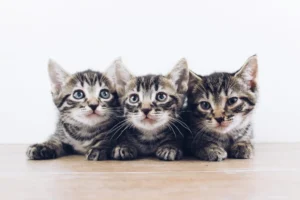Cats have a certain air of mystery about them, effortlessly moving through their surroundings with quiet grace and stealth. But why exactly are cats more quiet than other animals? Let’s explore the reasons behind their silent nature.
Evolutionary Adaptations
Cats’ natural instincts and evolutionary adaptations play a significant role in their quiet demeanor. Domestic cats are descended from solitary hunters, and their ancestors had to rely on stealth and silence to stalk their prey without being detected. This need for quiet hunting likely carried over through generations, leading to the quiet nature we see in cats today.
Additionally, cats are crepuscular animals, meaning they are most active during dawn and dusk. During these times, it is crucial for cats to be quiet to avoid alerting potential prey or predators. This evolutionary trait has ingrained the importance of silence in cats’ behavior, contributing to their quiet nature even in a domestic setting.
Hunting Techniques
Cats employ a variety of hunting techniques that require them to be quiet and stealthy. One of the most common tactics they use is stalking, where they move slowly and silently towards their prey before pouncing. This silence is essential for a successful hunt, as it prevents the prey from detecting the cat’s presence until it is too late.
Another hunting technique cats use is the “freeze and focus” method. In this technique, cats halt their movements and focus intensely on their target, waiting for the perfect moment to strike. Being quiet during this process is crucial to avoid alerting the prey and ensuring a successful catch.
Furthermore, cats have specialized auditory systems that allow them to detect even the slightest sounds, making silence a valuable asset in their hunting endeavors. By staying quiet, cats can better hear and locate their prey, increasing their chances of a successful hunt.
Key Tip: To encourage your cat’s natural hunting instincts in a safe and controlled environment, provide interactive toys that mimic prey movements and encourage stealth and silence during playtime.
Paw Pads
Cats are known for their stealthy and silent movements, a trait that can be attributed to their unique paw pads. Unlike dogs, cats have soft paw pads that are covered in tiny, soft bumps called papillae. These papillae act as cushions, absorbing the shock of their footsteps and muffling any noise they might make while walking. This design allows cats to move with incredible grace and silence, making them excellent hunters and sneaky companions.
Additionally, the structure of cats’ paw pads also provides them with excellent traction, enabling them to navigate various terrains silently. The soft, flexible pads allow them to control their movements with precision, further enhancing their ability to move around quietly.
Vocalizations
While cats are typically quiet when it comes to their movements, they are anything but silent when it comes to vocalizations. Cats have a wide range of vocalizations, from meows and purrs to hisses and growls, that they use to communicate with humans and other animals.
Despite their vocal capabilities, cats often choose to remain silent in certain situations. One reason for this silence is their natural instinct for stealth and hunting. Remaining quiet allows cats to sneak up on prey without alerting them to their presence. It also helps them avoid potential threats by staying hidden and undetected.
In addition, cats may also choose silence as a means of conserving energy. By minimizing vocalizations and focusing on their movements, cats can save their energy for more important tasks, such as hunting or playing.
Finally, silence can also serve as a form of communication for cats. In the wild, remaining silent can signal to other animals that they are in control of a situation or that they are ready to pounce. By staying quiet, cats can assert their dominance or readiness without the need for vocalizing.
Plus, contrary to popular belief, sometimes cats are simply quiet because they are content and relaxed, choosing to express themselves through body language and physical gestures rather than vocalizations.
Domestication
Domestication has played a pivotal role in influencing cats’ behavior and maintaining their quiet tendencies. Over thousands of years, cats have evolved alongside humans, adapting to live in close proximity to us. This has led to the development of a more docile and quieter nature in domesticated cats compared to their wild counterparts.
Due to their close association with humans, cats have learned to communicate and interact with us in a quieter manner. Unlike dogs, who bark loudly to alert their owners, cats have developed subtler ways of getting their point across, such as gentle meowing or purring. This quiet behavior has helped cats integrate seamlessly into human households and earn the title of “the silent companion.”
Furthermore, domesticated cats have inherited their ancestors’ stealthy hunting instincts, which also contribute to their quiet demeanor. In the wild, staying quiet while stalking prey is essential for a successful hunt. This innate behavior has been preserved in domestic cats, making them naturally quiet and agile creatures around the house.
In conclusion, domestication has shaped cats’ behavior to be more quiet and refined, making them beloved companions in millions of homes worldwide.
Sleeping Patterns
Cats’ sleeping patterns play a significant role in contributing to their quiet nature. These graceful felines are known for their long hours of sleep, with an average of 12-16 hours per day. This excessive amount of rest serves a crucial purpose in conserving energy for other activities, such as hunting and play.
Cats are crepuscular creatures, meaning they are most active during dawn and dusk. By resting for extended periods throughout the day, they ensure they have the energy to engage in their natural behaviors during these peak hours. This sleep strategy not only helps cats maintain their quiet demeanor but also provides them with the vitality needed to showcase their agility and hunting skills.
Moreover, cats’ quiet nature during sleep is also a survival mechanism inherited from their wild ancestors. Remaining still and silent while resting helps cats avoid detection by potential predators, ensuring their safety in a world full of dangers.
In essence, cats’ unique sleeping patterns are intricately linked to their quiet nature, enabling them to conserve energy, stay alert, and be the stealthy hunters we know and love.
Additional Insight:
– Providing your cat with a comfortable, quiet sleeping space can help them feel secure and promote healthier sleeping habits.
Noise Aversion
Some cats may be naturally more quiet due to a noise aversion. Just like humans, felines can be sensitive to loud sounds, which may make them more inclined to stay quiet in order to avoid potential stress or discomfort. If your cat tends to be on the quieter side, it might be worth considering their environment and whether there are any loud noises that could be causing them distress. Providing a quiet, calm space for your cat to retreat to can help alleviate their anxiety and encourage them to express themselves more freely.
Social Behaviors
Cats are known for their independent nature, but they are also social creatures who rely on communication with their fellow felines. In social situations, cats may opt to be more quiet in order to avoid conflict or assert dominance without the need for vocalizations. Quieter cats may use body language and subtle cues to communicate with other cats, rather than vocalizing loudly. Creating a peaceful and harmonious environment for your cat can help them feel more comfortable and secure, allowing them to express themselves in their own unique way.
Additional unique insight: Quiet cats may also use their silence as a form of stealth while hunting. By minimizing noise, they can sneak up on prey more effectively, showcasing their natural hunting instincts.
Fun Facts About Cat Communication
Did you know that cats communicate primarily through body language, vocalizations, and scents? Unlike dogs who are known for their barking, cats tend to be more quiet and subtle in their communication style. For example, a cat’s tail position can indicate their mood – a twitching tail might signify irritation, while a held-up tail shows confidence. Another interesting fact is that cats meow mostly to communicate with humans, not with each other.
Tips for Understanding Your Cat’s Behavior
- Pay attention to your cat’s body language – their ears, eyes, and tail can give you clues about how they are feeling.
- Respect your cat’s need for personal space and independence. Cats are known for their aloof nature and may not always want to be cuddled or petted.
- Provide mental and physical stimulation for your cat to prevent boredom, which can lead to destructive behaviors.
- Regular veterinary check-ups are essential to ensure your cat’s health and well-being.
- Remember that every cat is unique, so take the time to understand your feline companion’s individual quirks and preferences.
By being mindful of your cat’s communication cues and behavior, you can build a stronger bond with your furry friend and create a harmonious living environment.
Alex, a passionate animal lover, has experience in training and understanding animal behavior. As a proud pet parent to two dogs and three cats, he founded AnimalReport.net to share insights from animal experts and expand his knowledge of the animal kingdom.









